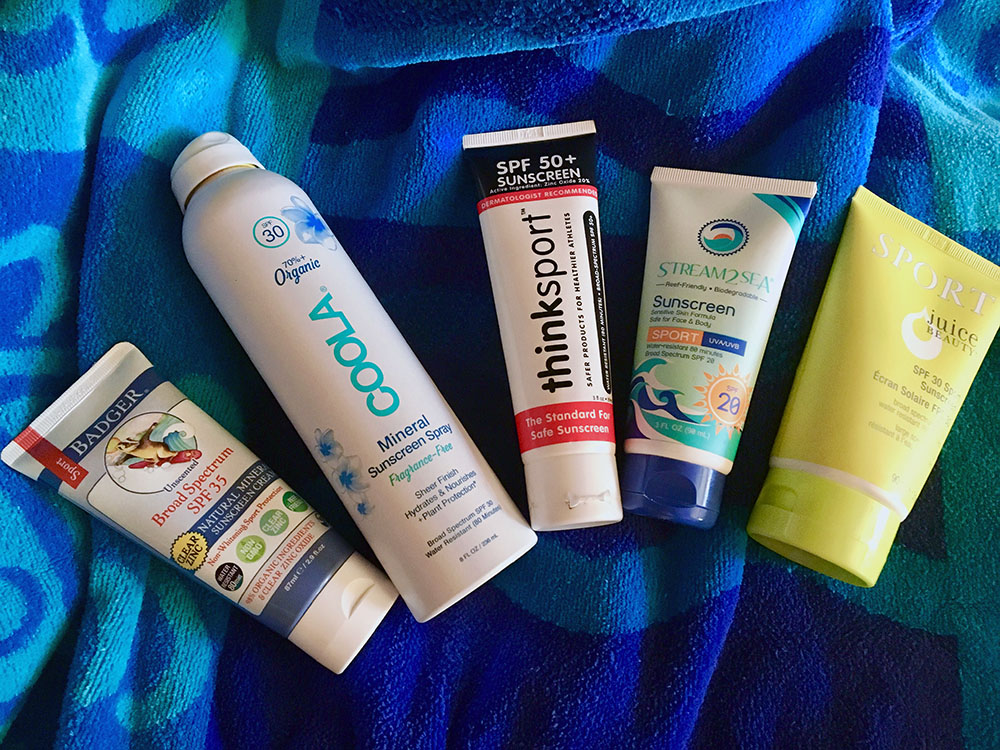We tested 5 reef-safe sunscreens. Here is what we thought.

Sunscreen is essential to protect against the harmful rays of the sun during summer fun, but some sunscreens can harm reef ecosystems. Eco-conscious consumers increasingly seek out reef-safe sunscreens, but with the range of available options and seemingly inscrutable ingredients lists, buyers are often left wondering what will work for both the oceans and their skin.
The National Park Service estimates that between 4,000 and 6,000 tons of sunscreen washes off in reef environments every year. Many sunscreens contain UV-blocking chemicals called oxybenzone and octinoxate, which are harmful to aquatic life and promote viral infections in coral reefs that cause bleaching. Sunscreen can even find its way into waterways through runoff from showering sunbathers.
In July 2018, Hawaii became the first state to ban the sale of sunscreens containing oxybenzone and octinoxate. Officials in Key West, Florida, also voted for a ban that will go into effect in 2021 on the sale of sunscreens with those ingredients. Though critics of the bans that say they may encourage people to skip sunscreen altogether, new reef-safe sunscreens entered the market to take advantage of the increased demand.
Reef-safe sunscreens are generally made with zinc oxide or titanium dioxide, which are not associated with reef bleaching. Rather than absorbing into the skin like traditional sunscreens, the particles of these mineral-based ingredients sit on top of the skin to block the sun’s harmful rays. The most eco-friendly reef-safe sunscreens will also indicate that they are “non-nano,” meaning the particles are large enough that they cannot be ingested by corals.
Such distinctions are important, even for supposedly reef-safe ingredients. A 2018 study conducted by Marche Polytechnic University in Italy showed that larger zinc oxide particles and certain popular modified forms of titanium dioxide still cause damage to coral reefs, though critics of the study said that it is not large-scale enough to be definitive. Even the International Coral Reef Initiative agreed that more research needs to be done on such products.
Some consumers also complain that these reef-safe sunscreens are unpleasant to apply, difficult to blend into the skin or — most concerningly — less effective. That’s where I come in.
Though I am something of an eco-friendly beauty product connoisseur, I knew that my olive-toned skin was not going to give me the roasting I needed to determine if these reef-safe sunscreens are effective. So I enlisted the help of my paler colleague, Julia Bayly, to make sure my results held up, even among the fair and freckled.
We tested each tested the sunscreens at the same time on different parts of our bodies, but our trials occurred on different days and occasions. I tested them on a kayak trip where they were sure to get wet to test the water-resistant claims.

Julia’s experiment took place on an unshaded bike ride.
We judged each product based on scent, application, water-resistance and effectiveness at protecting against burns. Here’s what we thought.
Thinksport Safe Sunscreen SPF 50+ ($12.99 for 3 oz)
Thinksport’s Safe Sunscreen boasts more awards than any other sunscreen brand on the market. It was the first sunscreen to pass Whole Foods Premium Care Requirements and has received top ratings from the Environmental Working Group for nearly a decade. The non-nano zinc oxide product has the highest allowed SPF, broad-spectrum UVA and UVB protection and biodegradability, and it is water resistant up to 80 minutes. The sunscreen is also produced in the USA and received a Leaping Bunny certification for being created with no animal testing
Sam: The first thing I noticed about Thinksport Safe Sunscreen SPF 50+ was the sweet smell, almost like fruity, sugary cereal. The application was fairly pleasant. The consistency is thinner than some of the other sunscreens, so it left a slightly greasy feeling, but overall, I found it fairly easy to blend. Of all the sunscreens, though, this one actually left me with some redness, and I felt as though it washed off a bit on my thighs where the lake water splashed over the edge of my kayak.
Julia: Out of all five, this application left me with a slight reddish tinge — but not a burn — on the exposed area of my face, neck and upper chest. I liked that it did not run into my eyes when I was sweating during my ride, which is always a concern on long bike rides. However, I thought the application was greasy, and I had to really massage it in so there were no white globs or streaks left on my face.
Badger Sport Sunscreen SPF 35 ($15.99 for 2.9 fluid oz.)
The Badger Sport Sunscreen has a simple formula with just five ingredients — including non-nano zinc oxide, sunflower oil, beeswax and vitamin E — with no added fragrance for the benefit of sensitive skin. It claims to be water and sweat resistant for up to 80 minutes. Besides being reef-safe, it is also biodegradable, certified cruelty-free and non-GMO certified.
Sam: The Badger Sport Sunscreen has absolutely no scent, which I tend to prefer. It was, however, extremely chalky to apply. It comes out almost like a paste and requires quite a bit of rubbing. I could not blend it all the way in on my face and felt a little like I was wearing cheap face paint. It definitely works, though. When the water splashed me, the Badger Sport Sunscreen stayed put in all its pasty splendor. There is some reapplication required after the allotted 80 minutes, but I do think this was the most powerful in terms of burn blocking and water resistance.
Julia: On the bright side, I definitely didn’t burn. However, the Badger Sport Sunscreen was really goopy to rub in. Even after a shower, it felt like it was still on my arm. I suppose that speaks to its water resistance, but as a cyclist, I was less concerned about that than I was about the fact that it collected and held dust like flypaper when I rode over dusty, rocky roads. I definitely would not use this particular brand for cycling or non-water outdoor activities again.
Stream2Sea Sunscreen for Face and Body SPF 20 ($16.95 for 3 oz.)
Stream2Sea is made from a non-nano zinc oxide formula combined with green tea, tulsi, wakame and olive leaf that has been tested for biodegradability and aquatic toxicity. It boasts broad-spectrum UVA and UVB protection and water resistance for 80 minutes of activity. The packaging is eco-friendly, too: smaller sizes are sold in sugar cane resin tubes, while larger sizes are in containers made from recycled milk jugs.
Sam: I found the Stream2Sea Sunscreen for Face and Body slightly less pasty than Badger’s product (especially on my face), but it still felt resistant against the water and felt equally protective against the sun. I also really liked the scent, which is slightly grassy but not overwhelmingly sweet. I got some color on this one, too, but I think all the soothing antioxidant ingredients relieved any discomfort the redness may have caused. I do think that the product is a little expensive, especially for the low SPF, but it was effective.
Julia: I was pleasantly surprised by the Stream2Sea Sunscreen, given the lower SPF. My arm picked up a little color but did not burn. Like the Badger, though, I found it really goopy to rub in and even after a shower it felt like it was still on my arm. Again, it collects and holds dust when used in an activity like gravel cycling, but it definitely does not come off with perspiration.
Juice Beauty SPF 30 Sport Sunscreen ($16 for 3 fluid oz.)
The Juice Beauty SPF 30 Sport Sunscreen’s non-nano mineral zinc oxide sunscreen is made with organic coconut, aloe and jojoba provide antioxidant-rich hydration, as well as added vitamins C and E to promote skin health. The sunscreen is also made without parabens, petroleum, propylene, butylene glycol, sodium lauryl sulfates, pesticides, phthalates, artificial dyes or synthetic fragrances. The product is not tested on animals and claims to be water-resistant for up to 80 minutes.
Sam: I liked the scent of this sunscreen and I definitely did not burn, but it was incredibly thick and difficult to blend in. My leg was covered in white paste for the duration of my kayak trip. True to its water-resistance claims, the sunscreen did not come off in the water, but it also lingered on my skin well after I showered post-kayaking.
Julia: Of all the sunscreens we tested, this was absolutely the goopiest. I did not burn, but I was also not able to get it off my body. Even after a shower, it felt like it was still on my arm, and it collected significant amounts of dirt and dust from my ride over gravel roads. No burn, though.
COOLA Mineral Body Sunscreen Spray SPF 30 ($42 for 8 fluid oz.)
The non-nano zinc oxide spray advertises pioneering spray technology and a lightweight formula with a matte-finish made from sustainably-sourced ingredients. COOLA makes additional efforts to build their environmental sustainability brand. COOLA decreased the plastic used in their packaging by 30 percent. For World Oceans Day this past year, they partnered with Coral Gardeners to plant 100 healthy coral reefs.
Sam: This sunscreen came out shockingly thick given that it was a spray. True to its name, it does have a slightly cooling effect when applied, which is really pleasant, and the scent is lovely even though the “matte finish” felt sticky to me. This was also the one sunscreen I was certain washed off in the water, though I still managed to escape the trip without a gnarly burn. Honestly, I was floored by the price when I saw it. I feel like I go through aerosol sunscreens much faster than creams, so I can’t imagine spending this much on a can of sunscreen. Plus, the Food and Drug Administration is still evaluating the effectiveness of spray sunscreens, as users tend not to adequately apply them. The Environmental Working Group also recommends against spray sunscreens due to concerns over inhalation.
Julia: I did not experience any burning with this one, either, but how in the world is a spray sunscreen so goopy? As a cyclist, I was excited by the prospect of a matte finish, especially considering some of the other sunscreens persisted on my skin for so long after application, but it left me sticky and it was difficult to wash off in the shower. And, lo and behold, all the dirt and bits of gravel from my ride stuck to that same “matte” finish. At least it did not come off when I perspired.
The verdict
Sam: In terms of protecting my skin against burns, all of these reef-safe sunscreens worked for me. When considering the ease of application and price (aka, which sunscreen am I most likely to buy and use again — the most effective sunscreen is the one you use, after all), I would recommend Badger or Stream2Sea for water-resistant, reef-safe fun in the sun.
Julia: I burn quite easily, so overall, I was pleased with all of these and would use them again. For the price and how it worked, Thinksport is my top choice.
